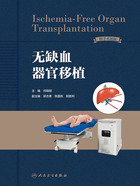
序二(原文)
Through the history of organ transplantation there has been a debate over the main question whether the encounter of foreign antigens or the response to organ injury sending danger signals represent the main drivers for the initiation of alloimmune responses that lead to the destruction of an organ transplant in the absence of appropriate therapeutic interventions. While the genetic disparity is in general considered critical and at the center, it has remained unclear if the consequences of ischemia-reperfusion injury are accelerating relevant immune responses. Ischemia/reperfusion injury characterized by the absence of oxygen and nutrition during a time when the organ is removed from an intact circulation with a subsequent cascade of inflammatory responses set in motion when the circulation in the recipient is re-established has up until now been an immanent part of organ transplantation. Being able to dissect the impact of injury vs genetic disparity is thus critical as a recipient of an organ transplantation has thus far always encountered a transplant that has been damaged by ischemia and reperfusion injury.
The work by Professor He and his many extraordinary talented clinicians and scientists at the First Affiliated Hospital of Sun Yat-sen University in Guangzhou, PR China have provided us-for the first time-with a clinical model that will allow to delineate and potentially separate the consequences of injury from those set-in motion by encountering foreign antigens. The work by this group is not only relevant for an improved outcome after transplantation but also expected to impact many areas of translational research.
Xenotransplantation is an area that has made great strides forward with most recent clinical applications and the potential of clinical trials in the near future. Yet, the impact of ischemia/reperfusion injury on outcomes and immune responses after xenotransplantation are not understood. Of relevance, large animal models have shown that the early injury caused by ischemia determined outcomes of xenotransplantations.
Clinically, the field of organ transplantation is hampered by a limited number of organs available for transplantation. At the same time, many organs, particularly from older and lessthan-optimal donors are currently either not considered or discarded after procurement for fear of compromised organ quality or inferior outcomes. Alternatives to a plain cold storage keeping organs in an ice box until transplantation have been around and machine preservation approaches have regained interest during the last decades with the demand of using organs from older or marginal donors. Most recently, we have seen an impressive progress with preservation devices. While those advancements are recognized and relevant, the approach of the ischemia-free organ preservation by the group at Sun Yat-sen offers additional novelty and potential. Not only is this method expected to reduce or entirely eliminate injury as a consequence of ischemia, but it will also facilitate the potential of treating organs ex-vivo under optimal conditions of a continuing perfusion.
Ischemia-free transplantation will also help to expand the application of tolerance protocols. Those approaches have thus far only been considered when utilizing optimal organs from healthy living donors. Clearly, considering organs from deceased donors will add an entirely new dimension in which organ injury will be playing an important role. The approach by Professor He and his group may thus also have a beneficial effect for the successful implementation of tolerance protocols.
Organs from deceased donors may not only be injured because of ischemia but may also suffer from the consequences of brain death and intensive care treatment. Brain death and intensive care treatment by themselves have been shown to play a role in initiating immune processes through an immune activation in organs used for transplantation. Those damaging effects have thus far not been able to be separated from the consequences of other injuries including ischemia/reperfusion injury. Again, utilizing an ischemia-free protocol will allow to delineate pathways of injury.
In addition to the many important questions that can be answered through this novel approach, it needs to be emphasized that masterfully performed surgeries are standing at the center when transplanting livers, kidneys, and hearts without ischemia. Witnessing this surgical mastery has been a privilege. Seeing a beating heart being transplanted is nothing short but breath taking.
The group in Guangzhou is already on the way to make their novel approach clinically available to a broader community and is performing experiments that are expected to help us understand some of the principal questions in organ transplantation and immunity. On a molecular detailed level, the group is currently delineating pathways of injury. This line of research has the potential to identify novel targets allowing to treating and conditioning organs while potentially aiding in applying tolerance protocols successfully when using organs from deceased donors.
Clearly, the work by Professor He and his group is most innovative. What we have seen thus far may only be the‘tip of the iceberg’of the broad impact that this work may have.
Stefan G. Tullius,MD,PhD
Pre-President of the American Society of Transplant Surgeons
Chief of Organ Transplant Center, Brigham and Women′s Hospital, Harvard University, USA
December,2022